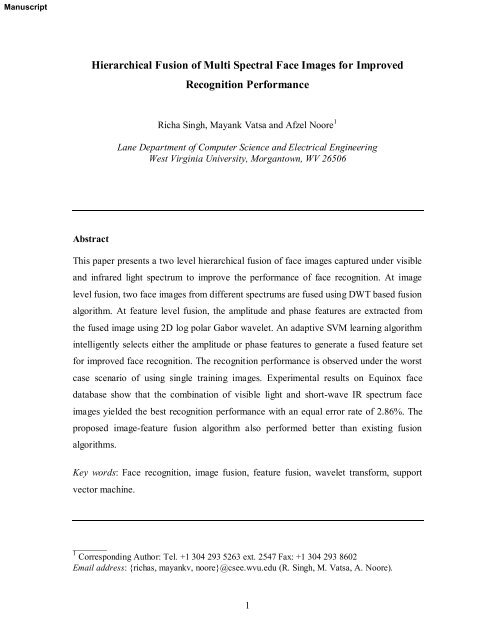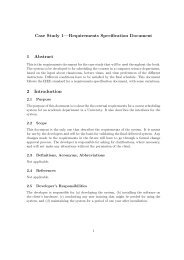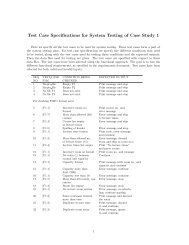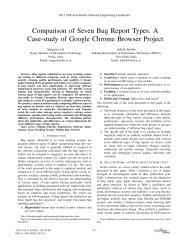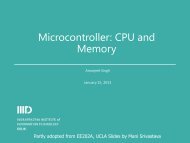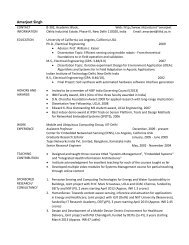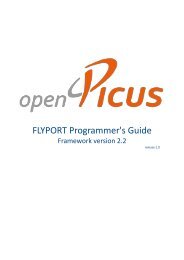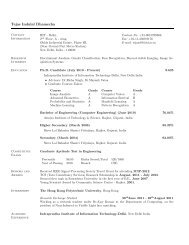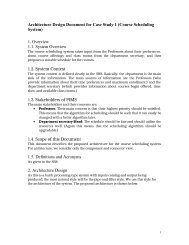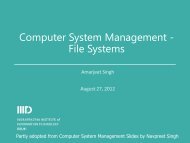Hierarchical Fusion of Multi Spectral Face Images for Improved ... - IIIT
Hierarchical Fusion of Multi Spectral Face Images for Improved ... - IIIT
Hierarchical Fusion of Multi Spectral Face Images for Improved ... - IIIT
You also want an ePaper? Increase the reach of your titles
YUMPU automatically turns print PDFs into web optimized ePapers that Google loves.
face is detected using triangle based face detection algorithm [10]. Let the size <strong>of</strong>detected face image I ( x,y)be N x N. <strong>Face</strong> image is trans<strong>for</strong>med into its log polar <strong>for</strong>m.The log polar trans<strong>for</strong>mation converts original face image I ( x,y)into I ( r,θ ) in whichthe angular coordinates are represented on the vertical axis and the logarithmiccoordinates <strong>of</strong> radius are represented on the horizontal axis. More precisely, with respectto a center point x , y ),(c cr = log ( x − xc)2+ ( y − yc)2, 0 ≤ r ≤ r−⎛ y − yθ tan 1 c⎞=⎜⎟ , 0 ≤ θ ≤ 2π⎝ x − xc⎠max(1)Here a crucial decision is the choice <strong>of</strong> center point x , y ). In a face image, there are(c cvery few points such as the center <strong>of</strong> mouth, eye locations, and nose tip which remainconsistent and are easy to locate. The proposed face detection algorithm uses thecoordinates <strong>of</strong> both eyes to detect a face image. The best choice is the center x , y ) <strong>of</strong>(c cline joining the two eye coordinates and the proposed algorithm uses this point as thecenter point. The mapping process converts the scale change and rotation <strong>of</strong> face imageinto constant horizontal and cyclic vertical shifts in the log polar plane. This processeliminates the need <strong>for</strong> using multiple templates to cover scale and rotation variations <strong>of</strong>face image.In the next step, polar face image is expressed into 2D Fourier domain,1⎡ 2πr 2πj ⎤I ( ρ,φ)= ∑∑I( r,θ j ) exp⎢−i ρ + φµλ⎥ (2)r j⎣ µ λ ⎦4
where, θ j=2πjλ, 0 ≤ r < µ , 0 ≤ j < λ , µ and λ are the radial and angular frequencyresolutions respectively.2D Fourier trans<strong>for</strong>m <strong>of</strong> face image is convolved with the 2D Fourier trans<strong>for</strong>m <strong>of</strong> logpolar Gabor wavelet G ( ρ,φ). Log polar Gabor is a <strong>for</strong>m <strong>of</strong> log Gabor wavelet [4] whichis based on polar coordinates and the dependency <strong>of</strong> directional independent variance (σ)on the polar coordinate is realized by a logarithmic scale. Thus the functional <strong>for</strong>m <strong>of</strong> 2Dlog polar Gabor filter can be represented as,⎛ ⎡22 ⎤⎞G ( r,θ ) = exp⎜−2π2σ2⎢⎛()⎞+⎛()⎞⎥⎟⎜⎜ ⎜⎛ − ⎟⎞⎜lnr − ln⎜⎛r⎟⎞⎟ ln r sin θ θ ⎟ (3)r , θ⎟⎝⎢⎝⎝ 0 ⎠⎠⎝ ⎝ 0 ⎠⎠0 0⎣⎥⎦⎠and the position <strong>of</strong> filter in the Fourier domain is defined byr 00 = 2, 2 ir 0 i = r00, 2πθ0 i = i(4)Nθwhere r 00 is the smallest possible frequency, N θ is the number <strong>of</strong> filters on the unitcircle, and at index L, σ L and s L are further defined byσL=ln1 ln 2( r ) π sin⎛π2⎞0 ⎜ ⎟⎝ Nθ⎠(5a)s L=2ln( r0 ) π sin⎛ ⎞⎜π⎟⎝ Nθ⎠lnln 2( 2) 2(5b)5
Inverse Fourier Trans<strong>for</strong>m (IFT) <strong>of</strong> the convolved face image is computed and the outputI g ( r,θ ) is a complex valued matrix containing the amplitude and phase in<strong>for</strong>mation.⎛⎞I⎜( ) ( )⎟g ( r,θ ) = IFT⎜∑∑Iρ,φ * G ρ,φ ⎟(6)⎝ r j⎠Amplitude feature is computed from the matrix I g ( r,θ ) using Equation 7. Phasein<strong>for</strong>mation is extracted using Equation 8 and then quantized to obtain the binary phasefeature or template using Equation 9 which is used <strong>for</strong> recognition. The amplitude andphase features are shown in Fig. 1.F( Re I ( r,θ )) 2 Im I ( r,)( ) 2( r,θ)= θ(7)A g +gP(r,θ ) = tan−1⎛ Im I⎜⎜⎝Re Igg( r,θ )⎞( )⎟ ⎟ r,θ ⎠(8)( P( r,θ ))( P( r,θ ))( P( r,θ ))( P( r,θ ))00⎧[1,1] if 0 < Re ≤ 90⎪00⎪[0,1]if 90 < Re ≤ 180F P ( r,θ ) = ⎨(9)00⎪[0,0]if 180 < Re ≤ 270⎪00⎩[1,0] if 270 < Re ≤ 360Fig. 1. (a) <strong>Face</strong> image (b) Amplitude features, (c) Phase features6
To match the two amplitude feature templates, F A1and F A2,a) The amplitude features are divided into z number <strong>of</strong> frames, each <strong>of</strong> size k x l.b) Corresponding frames from the two amplitude templates are matched usingcorrelation distanceiCDAgiven in Equation 10.iCDAi iF F=A1 ⊗ A2, i = 1 ,2,…,z(10)k lc) The amplitude matching score MS A is calculated using Equation 11.MSIA⎪⎧MS= ⎨⎪⎩ MSIAIAMS+ 1A =ififMSzIACDCDiAiA≥ T< TIAIA(11)whereT IA is the frame matching threshold, MS IA is the intermediate amplitudematching score, and z is the number <strong>of</strong> frames.d) A match occurs if the amplitude matching score, MS A , is greater than the matchingthreshold, T A.To match the two phase feature templates, F P1andF P2,a) The phase templates are divided into m frames, each <strong>of</strong> size p x q.b) Corresponding frames from the two phase templates are matched using hammingdistance given in Equation 12.HDiP=∑FiP1⊕ Fp qiP2, i = 1 ,2,…,m(12)7
whereiPF 1 andiFP2are the i th frames <strong>for</strong> the two phase templates, andiHDPis thecorresponding hamming distance measure.c) The phase matching score MS P is calculated using Equation 13,MSIP⎪⎧MS= ⎨⎪⎩ MSIPIP+ 1ififHDHDiPiP≤ T> TIPIP(13)MSP =MSmIPwhere T IP is the frame matching threshold, MS IP is the intermediate phase matchingscore, and m is the number <strong>of</strong> frames.d) A match occurs if the phase matching score, MS PthresholdT P ., is greater than the matchingThe advantage <strong>of</strong> the proposed face recognition algorithm is that the amplitude and phasefeatures extracted from the filter response <strong>of</strong> face image are invariant to frequency, scaleand orientation <strong>of</strong> the filter. Here we trans<strong>for</strong>m the problem <strong>of</strong> recognizing a face into anefficient test <strong>of</strong> statistical dependence operating on amplitude variation and statisticalindependence operating on phase variation. Also, Venkatesh and Owens [26] show thatthe phase is independent <strong>of</strong> the overall magnitude <strong>of</strong> face image and provides invarianceto the changes in illumination and contrast. Log polar trans<strong>for</strong>mation eliminates thenecessity <strong>of</strong> using multiple templates to handle the variations due to scale and rotation.Thus the amplitude features in the proposed face recognition algorithm are invariant t<strong>of</strong>requency, scale, and orientation; while the phase features are invariant to frequency,scale, orientation, illumination and contrast.8
3 <strong>Fusion</strong> at Image level and Feature Level <strong>for</strong> Enhanced Per<strong>for</strong>manceIn [20], it has been suggested that biometric in<strong>for</strong>mation fusion can be used to enhancethe recognition per<strong>for</strong>mance. In<strong>for</strong>mation fusion can be per<strong>for</strong>med at five levels namelydata or image level, feature level, match score level, decision level, and rank level.Researchers have proposed several algorithms [5], [14], [20] <strong>for</strong> fusion at match scorelevel and decision level. Kumar [16], Ross [21], and Singh [23] proposed algorithms <strong>for</strong>feature level fusion, and Chang [6] and Singh [23] proposed algorithms <strong>for</strong> image levelfusion. In this section, we present algorithms <strong>for</strong> both feature and image level fusion inface biometrics. The two levels <strong>of</strong> fusion are further combined hierarchically to increasethe recognition per<strong>for</strong>mance.3.1 <strong>Fusion</strong> <strong>of</strong> Features from Single Spectrum <strong>Face</strong> ImageFeature fusion in biometrics has been addressed by several researchers [21], [23] in theliterature. In [21], feature fusion is per<strong>for</strong>med by concatenating two feature vectors.Singh et al. [23] fuse the eigen vectors <strong>of</strong> visible and IR face image using geneticalgorithms. In the proposed approach, a learning based algorithm is used to fuse theamplitude and phase features from a face image. There are several learning algorithmsbased on neural networks which can be trained to learn and identify features. However,one <strong>of</strong> the major drawbacks with neural network based approach is choosing a mappingfunction between the input data space and the output feature space. The mapping functionmay be inefficient in determining the local minima consistently. When a large set <strong>of</strong>9
training data is used, it could lead to overfitting and hence poor generalization affectingthe matching per<strong>for</strong>mance. Learning algorithms have several parameters which arecontrolled heuristically, making the system difficult and unreliable to use. Also,traditional multilayer neural networks suffer from the existence <strong>of</strong> multiple local minimasolutions. To alleviate these inherent limitations, we use Support Vector machine (SVM)based learning algorithms <strong>for</strong> feature fusion. SVM training always finds a globalminimum by choosing a convex learning bias. In classical SVM, the goal is to minimizethe probability <strong>of</strong> making an error. Furthermore, the parameters <strong>of</strong> SVM can be set topenalize the errors asymmetrically by assigning costs to different errors to minimize theexpected misclassification cost. This approach, known as dual υ -Support VectorMachines (2υ -SVM) [9], can also address the difficulties that arise when the classfrequencies in training data do not accurately reflect the true prior probabilities <strong>of</strong> theclasses. Considering all these properties and advantages, our proposed algorithm uses2υ -SVM [9]. 2υ -SVM is applied as a two class problem, classifying good feature classand bad feature class. Proposed by Chew et al. [9], 2υ -SVM can be expressed asfollows:x , be a set <strong>of</strong> n data vectors with xLet { } i y iid∈ R , y ∈ +1,−1and i = 1,...,n. xii is the i thdata vector that belongs to a binary class y i . The objective <strong>of</strong> training 2υ -SVM is to findthe hyper-plane that separates any two classes with the widest margins, i.e.,ω ( x)+ b = 0subject to yi( ω ϕ x)+ b) ≥ ρ −ψi( , ψ ≥ 0 ,i(14)10
12to minimize ω 2 − ∑C( υρ −ψ)iiiwhere ρ is the position <strong>of</strong> the margin and υ is the error parameter. ϕ is the mappingfunction to map the data space to the feature space. It is used to provide generalization tothe decision function that may not be a linear function <strong>of</strong> the training data. C ( ψ )the cost <strong>of</strong> errors, ω is normal vector, b is bias, andiυρ − isψ i is the slack variable <strong>for</strong>classification errors. υ is the error parameter that can be calculated using υ + anderror parameters <strong>for</strong> training <strong>of</strong> positive and negative classes respectively.iυ − ,2υ+ υ−υ = , 0 < υ+< 1 and 0 < υ−< 1 (15)υ + υ+−Error penalty C i is calculated as,where,⎧C+, if yi= + 1Ci= ⎨(16)⎩C−, if yi= −1CC+−⎡ ⎛ υ + ⎞⎤= ⎢n+⎜1+⎟⎥ ⎣ ⎝ υ−⎠ ⎦⎡ ⎛ υ ⎤− ⎞= ⎢n−⎜1+⎟⎥⎣ ⎝ υ+⎠⎦−1−1(17)and n + and n - are the number <strong>of</strong> training points <strong>for</strong> the good and bad classes respectively.2υ -SVM training can be <strong>for</strong>mulated as,11
max⎪⎧ 1⎨ −⎪⎩ 2∑( αi j yiy j Ki ) α αi ,i,j⎪⎫( x x ) ⎬ ⎪⎭jwhere,0 ≤ α ≤ C(18)∑i∑iα yiα ≥ υiiii= 0i , j ∈ 1, ...,n and the kernel function isK( x x ) = ϕ ( x ) ϕ ( x )i, (19)jij2υ -SVM is initialized and optimized using iterative decomposition training [9], whichleads to reduced complexity <strong>of</strong> 2υ -SVM. If the size <strong>of</strong> data vectors is n, then thecomplexity without optimization is O(n 2 ) and with optimization is O(n) [9]. In thissection, we consider the fusion <strong>of</strong> phase and amplitude features extracted from a faceimage. The proposed fusion algorithm, shown in Fig. 2, is described as follows:Amplitude Features<strong>Face</strong> ImageSVMLearningbasedFeature<strong>Fusion</strong>Fused FeatureVectorPhase FeaturesFig. 2. Block diagram <strong>for</strong> feature level fusion12
Let amplitude features F A and phase features F P be extracted from a face image. Both thefeatures are divided into windows <strong>of</strong> size 3 x 3 to calculate the weighted average windowbased activity. A total <strong>of</strong> n activity levels are computed and provided as input to the 2υ -SVM which is then trained to determine whether the coefficient from the amplitudefeature set F A or the phase feature set F P should be used. At any position (x, y), if thefeatures <strong>of</strong> F A are classified as “good” and the SVM classification margin <strong>of</strong> F A is greaterthan the SVM classification margin <strong>of</strong> F P , then output O(x, y) <strong>of</strong> the learning algorithm is1 otherwise the output is -1. As shown in Equation 20, amplitude and phase features areselected depending on the output O ( x,y).⎧FAFF(x,y)= ⎨⎩FP( x,y)( x,y),,ififO(x,y)> 0O(x,y)< 0(20)where FF is the fused feature vector. Furthermore, to match the two fused feature vectors,FF1and FF 2, the correlation based matching technique is applied. The features are firstdivided into m frames, each <strong>of</strong> size k x l. The correlation distance, CDiF, between twocorresponding frames is computed using Equation 21. Using the frame matchingthresholdT IF , the intermediate matching score MS IF <strong>for</strong> the frames and the finalmatching scoreMS F is calculated using Equation 22. A person is said to be matchedif MS F is greater than the fused feature vector matching threshold, T F .CDiFiiFF FF=1 ⊗ 2 , i = 1 ,2,…,m(21)k l13
MSF⎪⎧MS= ⎨⎪⎩ MSIFIFMS+ 1F =ififMSmIFCDCDiFiF≥ T< TIFIF(22)3.2. <strong>Fusion</strong> <strong>of</strong> Features from <strong>Multi</strong> <strong>Spectral</strong> <strong>Face</strong> <strong>Images</strong>To enhance the per<strong>for</strong>mance <strong>of</strong> face recognition, the amplitude and phase features <strong>of</strong> faceimages from different spectrum are fused as shown in Fig. 3. Features are extracted fromtwo single-spectrum face images using the algorithm described in Section 2. For eachimage, the extracted amplitude and phase features are fused using the algorithm describedin Section 3.1 to generate two fused feature vectorsFF V andFF IR in visible andinfrared spectrum respectively. These fused feature vectors are then combined usingEquation 25, to generate an optimal fused feature vector, FF − ,VIR⎧FA−V, if O1(x,y)> 0FFV = ⎨⎩FP−V, if O1( x,y)< 0(23)⎧FA−IR,if O2( x,y)> 0FFIR = ⎨⎩FP−IR,if O2( x,y)< 0(24)⎧ FFV, if O3( x,y)> 0FFV −IR= ⎨⎩FFIR,if O3(x,y)< 0(25)where O x,y),O ( x,) and O ( x,) are the outputs <strong>of</strong> the three trained 2υ -SVM. These1( 2 y3 yfeature vectors are further matched using the correlation based matching described in14
Equations 21 and 22. The SVM based feature fusion approach can handle images thathave variations in occlusion and expression.3.3 <strong>Fusion</strong> <strong>of</strong> <strong>Multi</strong> <strong>Spectral</strong> <strong>Face</strong> <strong>Images</strong>Image level fusion <strong>for</strong> the IR and visible face images has been proposed by variousresearchers [12], [13], [23]. These algorithms are generally based on learning techniquessuch as genetic algorithms which are computationally intensive. In this paper, we proposean algorithm to fuse the visible and IR face image using DWT with mother waveletDaubechies 9/7 [2]. This mother wavelet is chosen because it is among the best filters <strong>for</strong>wavelet based operations such as image compression when operating in a distributedenvironment [27].Amplitude Features<strong>Face</strong> Image(Spectrum 1)Phase FeaturesAmplitude FeaturesSVMbasedFeature<strong>Fusion</strong>Fused FeatureVectorSVMbasedFeature<strong>Fusion</strong>Fused FeatureVector from<strong>Multi</strong> <strong>Spectral</strong><strong>Images</strong><strong>Face</strong> Image(Spectrum 2)Phase FeaturesSVMbasedFeature<strong>Fusion</strong>Fused FeatureVectorFig. 3: Feature fusion from multi spectral face images15
Since the visible and IR imaging devices usually have different spatial resolutions andviewpoints, face images may exhibit different pose and size. Be<strong>for</strong>e fusion, face imagesshould be normalized and aligned. <strong>Face</strong> region is first detected using the triangle basedface detection algorithm [10]. Preprocessing is then per<strong>for</strong>med using affinetrans<strong>for</strong>mation, which also handles the rotation, translation and scaling.Let x , ) , x , ), and x , ) be the eyes and mouth coordinates respectively in the( 1 y1( 2 y2( 3 y3visible image and x ′,′), x ′ , ′ ), and x ′ , ′ ) be the corresponding coordinates in( 1 y1( 2 y2( 3 y3the IR face image. We calculate a trans<strong>for</strong>mation matrix TM to align the two detectedface images,−1⎡x1′x′2 x3′⎤⎡x1x2x3⎤TM =⎢⎥⎢⎥ ×⎢y1′y′2 y3′(26)y⎥1 y2y3⎣⎦⎢⎣111 ⎥⎦which gives⎡u1v1w1⎤TM = ⎢⎥(27)⎣u2v2w2⎦This trans<strong>for</strong>mation is generalized to the whole image,x = u ′ ′ +1x+ v1y w1y = u ′ ′ +2x+ v2y w2(28)Let I V and I IR be the preprocessed visible and IR face images. First, the pixel values <strong>of</strong> I Vand I IR are trans<strong>for</strong>med in the range <strong>of</strong> (0, 1). Single level DWT is then applied on theseimages to obtain the detail and approximation wavelet bands <strong>for</strong> both the images. Let16
ILL− V, ILH −V, IHL−Vand IHH − Vbe the four bands from visible face image andILL− IR, ILH −IR, IHL−IRand HH IRI−be the corresponding bands from IR face image asshown in Fig. 4. To preserve the features from both the images, coefficients fromapproximation band <strong>of</strong> I V and I IR are averaged,ILL−= mean I−, I−)(29)F( LL V LL IRwhereILL− Fis the approximation band <strong>of</strong> the fused image. For the three detailed bands,each band is divided into windows <strong>of</strong> size 3 x 3 and the sum <strong>of</strong> absolute value <strong>of</strong> all thepixels in each window is calculated. Binary decision maps, DM, are generated <strong>for</strong> all thethree detail bands using Equations 30, 31, and 32. A value ‘1’ is assigned if the windowfrom visible image has a value greater than the corresponding window from the IRimage; otherwise a value ‘0’ is assigned.⎧⎪1if max3×3 ( ILH −V) > max3×3 ( ILH −IR)DMLH= ⎨(30)⎪⎩0if max3×3 ( I LH −V) < max3×3 ( I LH −IR)⎧⎪1if max3×3 ( IHL−V) > max3×3 ( IHL−IR)DMHL= ⎨(31)⎪⎩0if max3×3 ( I HL−V) < max3×3 ( I HL−IR)⎧⎪1if max3×3 ( IHH −V) > max3×3 ( IHH − IR)DMHH= ⎨(32)⎪⎩0if max3×3 ( I HH −V) < max3×3 ( I HH − IR)where DM LH, DM HL, and DMHHare the binary decision maps <strong>for</strong> three detail bands,shown in Fig. 5.17
DWTLLLHHLHHVisible<strong>Face</strong> ImageImage<strong>Fusion</strong>IDWTDWTLLLHHLHHFused Visibleand IR ImageMedium WaveIR <strong>Face</strong> ImageFig. 4. <strong>Multi</strong>spectral image level fusion <strong>of</strong> visible and medium-wave infrared face imagesFig. 5. Decision maps <strong>for</strong> the horizontal, vertical and diagonal bandsBased on these decision maps, the detailed bands <strong>for</strong> the fused imageILH − F, IHL−Fand IHH −Fbands to generate the fused image.are generated. Inverse DWT is then applied on the four fusedIF= IDWT I , I , I , I ) (33)( LL −FLH − F HL−FHH − FTo validate the image fusion algorithm, recognition per<strong>for</strong>mance <strong>of</strong> the fused face imageis calculated. Amplitude and phase features are extracted from the fused image andmatched independently as described in Section 2. <strong>Face</strong> images captured using different18
light spectrum yields complementary in<strong>for</strong>mation that is useful <strong>for</strong> identification. Forimproved recognition per<strong>for</strong>mance, the fusion <strong>of</strong> this distinct multi-spectral in<strong>for</strong>mationinto a single image requires that the same image be captured using different lightspectrum.For an image <strong>of</strong> size N x N, the computational complexity <strong>of</strong> DWT and IDWT is2⎛ N ⎞O ⎜⎟ [1]. The fusion process has a complexity <strong>of</strong> O ( N log N). Hence the overall⎝ 4 ⎠complexity <strong>of</strong> the proposed image fusion algorithm is2⎛ N⎟ ⎞O ⎜ when N > 8 . This shows⎝ 4 ⎠that the image fusion algorithm is fast and can be used <strong>for</strong> real time applications.3.4 Integration <strong>of</strong> Image <strong>Fusion</strong> and Feature <strong>Fusion</strong>The algorithms proposed <strong>for</strong> both image level fusion and feature level fusion arecombined to further enhance the recognition per<strong>for</strong>mance. Fig. 6 shows the blockdiagram to hierarchically combine both the image and feature fusion techniques. <strong>Face</strong>images from different spectrums, e.g. short-wave IR and long-wave IR, are fused usingthe image fusion algorithm described in Section 3.3. The amplitude and phase featuresextracted from the fused image are then fused using the feature fusion algorithmdescribed in Section 3.1 to generate a composite feature vector. Correlation techniquedescribed in Section 3.1 is used to match the two fused feature vectors.19
Short Wave IR<strong>Face</strong> ImageAmplitudeFeaturesImage<strong>Fusion</strong>usingDWTFused <strong>Face</strong>ImageSVMLearningbasedFeature<strong>Fusion</strong>Fused FeatureVector <strong>for</strong><strong>Face</strong> RecognitionLong Wave IR<strong>Face</strong> ImagePhaseFeaturesLevel1-Image<strong>Fusion</strong>Level2-Feature <strong>Fusion</strong>Fig. 6. Two-level hierarchical fusion <strong>of</strong> multi spectral face images4 Experimental ResultsExperiments are per<strong>for</strong>med on the face database from Equinox Corporation [29]. Thedatabase contains images captured in long-wave, medium-wave and short-wave infraredlight along with the images in the visible spectrum. Visible spectrum captures theelectromagnetic energy in the range 0.4 - 0.7 µ m, and infrared spectrum comprises <strong>of</strong>thermal and reflectance wavebands in the range <strong>of</strong> 0.7 - 14.0 µ m. Short-wave infrared(SWIR) which is in the range <strong>of</strong> 0.9 - 2.4 µ m is reflective. Thermal IR spectrum isdivided into two parts, medium-wave infrared (MWIR) from the spectral range <strong>of</strong> 3.0 -5.0 µ m and long-wave infrared (LWIR) from 8.0 - 14.0 µ m. Emitted radiation dependson the temperature and emissivity <strong>of</strong> the material. There are images from 91 individualsin the database with variations in facial expression, illumination, and occlusion due toglasses <strong>for</strong> all four light spectrums. The results are divided into two parts. First part20
presents the per<strong>for</strong>mance <strong>of</strong> the proposed face recognition algorithm <strong>for</strong> differentvariations on the images from four light spectrums. We also present the recognitionper<strong>for</strong>mance with variation in number <strong>of</strong> training images. Second part presents theper<strong>for</strong>mance <strong>of</strong> face recognition with the image and feature fusion algorithms.4.1 Per<strong>for</strong>mance <strong>of</strong> <strong>Face</strong> Recognition Algorithm<strong>Face</strong> is detected from the image using the triangle based face detection algorithm [10].Per<strong>for</strong>mance <strong>of</strong> the proposed face recognition algorithm is then computed <strong>for</strong> differentvariations in all four spectrums. Fig. 7 shows an example <strong>of</strong> the amplitude and phasefeatures <strong>for</strong> images in all four spectrums.Original ImageAmplitude FeaturePhase FeatureVisible Short-wave Medium-wave Long-waveFig. 7. <strong>Face</strong> image from four spectrums with amplitude and phase features21
Figs. 8 and 9 show the Receiver-Operating Characteristic (ROC) curves using amplitudeand phase features respectively <strong>for</strong> face recognition. These two ROC plots show that theIR light spectrum contains more invariant features that are useful <strong>for</strong> face recognitioncompared to the visible light spectrum. In IR light spectrum, the per<strong>for</strong>mance <strong>of</strong> longwaveand medium-wave spectrum images are nearly the same, whereas the best resultsare obtained with short-wave IR images.30False Rejection Rate(%)25201510VisibleLong−Wave IRMid−Wave IRShort−Wave IR500 4 8 12 16 20 24False Accept Rate(%)Fig. 8. ROC <strong>for</strong> amplitude features30False Rejection Rate(%)25201510VisibleLong−Wave IRMid−Wave IRShort−Wave IR500 3 6 9 12 15 18False Accept Rate(%)Fig. 9. ROC <strong>for</strong> phase features22
To evaluate the per<strong>for</strong>mance <strong>of</strong> recognition algorithm with different variations, wefurther divide the database into three parts: images containing variation in expression,variation in illumination, and variation in occlusion due to glasses. The per<strong>for</strong>mance iscompared using equal error rate (EER) which indicates the value <strong>for</strong> which the falseacceptance rate is equal to the false rejection rate. Lower value <strong>of</strong> equal error rateindicates higher accuracy <strong>of</strong> the recognition algorithm. We used the equal error rate <strong>for</strong>the group with minor variations in expression as the baseline reference to compare andanalyze other experimental results. Table 1 shows the equal error rates <strong>of</strong> all fourspectrums with different variations. For the complete visible spectrum database, an EER<strong>of</strong> 12.72% and 11.58% is achieved using amplitude and phase features respectively. Thealgorithm is also found to per<strong>for</strong>m better than Principle Component Analysis (PCA) [3]and Linear Discriminant Analysis (LDA) based algorithms [3]. Similarly, <strong>for</strong> the three IRspectrums, amplitude and phase based face recognition algorithm per<strong>for</strong>ms three to fourtimes better than the PCA and LDA based face recognition algorithms. With long-waveIR (LWIR) and medium-wave IR (MWIR) face images, the equal error rate is higherwhen occlusions are present. This shows that the IR face images do not provideadditional in<strong>for</strong>mation when glasses are used, which is theoretically true because IRimages are opaque to glass. The results show that <strong>for</strong> visible and short wave IR images,illumination causes the equal error rate <strong>of</strong> amplitude features to increase compared to thephase features. Also, the results show that long wave and medium wave IR spectrum areinvariant to illumination variations since they capture the thermal property <strong>of</strong> the faceimage. Table 1 also shows that in all cases, minimum equal error rate is obtained withshort-wave IR (SWIR) face images.23
In specific applications such as law en<strong>for</strong>cement, only one image per person may beavailable <strong>for</strong> training the face recognition system [17], [22], [30]. Most <strong>of</strong> the facerecognition algorithms may not work well in such a scenario because they require largenumber <strong>of</strong> example images per class so that the intraclass variability could be consideredagainst the interclass similarity. We evaluated the per<strong>for</strong>mance <strong>of</strong> proposed facerecognition algorithm <strong>for</strong> such worst case scenario using short-wave IR face images. Fig.10 shows the identification accuracy <strong>of</strong> face recognition on varying the number <strong>of</strong>training images from seven to one. With seven training images, the identificationaccuracy <strong>of</strong> amplitude and phase features is nearly 100%. However as the number <strong>of</strong>training images decrease, the accuracy also decreases.Table 1Comparison <strong>of</strong> per<strong>for</strong>mance with variations in image features under different lightspectrum.Equal Error Rate (%)Algorithms Variation VisibleSpectrumLong-waveIRMid-waveIRShort-waveIRExpression 35.83 31.04 27.43 21.55PCA [3]Illumination 35.86 31.26 27.89 21.58Occlusion 35.92 32.79 28.90 21.61All variations 35.87 31.96 28.32 21.59Expression 31.22 26.13 23.83 18.33LDA [3]Illumination 31.37 26.69 23.99 18.32Occlusion 31.39 27.09 24.57 18.34All variations 31.24 26.71 24.04 18.33ProposedAmplitudeFeatureProposedPhaseFeatureExpression 12.69 10.22 10.13 6.01Illumination 13.07 10.36 10.21 6.22Occlusion 12.65 10.97 10.32 6.03All variations 12.72 10.45 10.18 6.06Expression 11.53 9.36 8.27 4.60Illumination 11.57 9.39 8.31 4.60Occlusion 11.64 10.18 8.64 4.62All variations 11.58 9.92 8.46 4.6124
A comparison with PCA [3] and LDA [3] has also been per<strong>for</strong>med by varying thenumber <strong>of</strong> training images. On decreasing the number <strong>of</strong> training images from seven toone, the accuracy <strong>of</strong> PCA algorithm is reduced by 46.95%, and the accuracy <strong>of</strong> LDAalgorithm is reduced by 44.21%. Comparatively, the amplitude and phase basedalgorithms maintain a higher level <strong>of</strong> accuracy at 96.87% and 97.34% respectivelyresulting in a decrease <strong>of</strong> only 3%. To determine the recognition per<strong>for</strong>mance <strong>for</strong> eachlight spectrum, the single training image belonging to the same light spectrum is used.These results show that the proposed face recognition algorithm is able to reduce theinterclass similarity and intraclass variability even with single training face image.10090Identification Accuracy(%)8070605040PhaseAmplitudePCAFLD301 2 3 4 5 6 7Number <strong>of</strong> Training <strong>Images</strong>Fig. 10. Accuracy <strong>of</strong> algorithms on varying the number <strong>of</strong> training images4.2 Per<strong>for</strong>mance <strong>of</strong> Image and Feature <strong>Fusion</strong> AlgorithmsPrevious studies on face recognition used only the visible and long-wave IR face images[8], [12], [13], [23], [24], [25]. In this research, we extend the study using our proposedapproach to all possible pairs <strong>of</strong> images captured from different light spectrums.25
Experiments <strong>for</strong> validating the fusion algorithms are carried out <strong>for</strong> four fusion schemesdescribed in Sections 3.1, 3.2, 3.3 and 3.4:Experiment 1: Feature fusion <strong>of</strong> amplitude and phase features extracted from a singlespectrum face image.Experiment 2: Feature fusion <strong>of</strong> amplitude and phase features extracted from multispectral face images.Experiment 3: Image fusion <strong>of</strong> two face images <strong>of</strong> different spectrum.Experiment 4: Image and feature fusion <strong>of</strong> two face images <strong>of</strong> different spectrum.These experiments are per<strong>for</strong>med using one training image per spectrum, e.g. one shortwaveIR and one visible face image are used <strong>for</strong> in<strong>for</strong>mation (image or feature) fusion.The fused image or feature vector obtained is used <strong>for</strong> training the texture basedrecognition algorithm. To determine the recognition per<strong>for</strong>mance <strong>for</strong> combinations <strong>of</strong>light spectrum and in<strong>for</strong>mation fusion, the single image used <strong>for</strong> training also has similarmulti-spectral fused image characteristics. In experiments 2, 3 and 4, images from twodifferent spectrum are fused. There are six possible pairs <strong>of</strong> light spectrum combinations.1. Long-wave IR with medium-wave IR (L-M)2. Long-wave IR with short-wave IR (L-S)3. Long-wave IR with visible (L-V)4. Medium-wave IR with short-wave IR (M-S)5. Medium-wave IR with visible (M-V)6. Short-wave IR with visible (S-V)26
Table 2 summarizes the equal error rates <strong>for</strong> these experiments. For cases when thefeatures are extracted and fused from only one image (experiment 1), short-wave IR givesthe best results with EER <strong>of</strong> 4.01% followed by visible spectrum face image, with theEER <strong>of</strong> 4.20%. The per<strong>for</strong>mance <strong>of</strong> long-wave and medium-wave IR are close to eachother with an EER <strong>of</strong> 8.26% and 7.88% respectively. Feature fusion with multi spectralface images (experiment 2) per<strong>for</strong>ms best <strong>for</strong> the combination <strong>of</strong> short-wave IR andvisible spectrum, with an EER <strong>of</strong> 3.27%. Further, <strong>for</strong> fusion <strong>of</strong> in<strong>for</strong>mation from twoimages (experiments 3 and 4), the combination <strong>of</strong> short-wave IR and visible spectrumper<strong>for</strong>ms best with the EER ranging from 2.86% to 3.59%.Table 2EER (%) <strong>for</strong> image and feature fusion algorithms using Equinox databaseAlgorithmsFeature <strong>Fusion</strong> –Single SpectrumFeature <strong>Fusion</strong> –<strong>Multi</strong> <strong>Spectral</strong>Image <strong>Fusion</strong>(Amplitude Features)Image <strong>Fusion</strong>(Phase Features)Image and Feature<strong>Fusion</strong>EER <strong>of</strong> Single Spectrum <strong>Images</strong>EER <strong>of</strong> Fused <strong>Images</strong>LWIR MWIR SWIR Visible L-M L-S L-V M-S M-V S-V8.26 7.88 4.01 4.20 -- -- -- -- -- ---- -- -- -- 3.99 3.81 3.94 3.62 3.78 3.27-- -- -- -- 6.23 5.33 5.26 3.98 4.72 3.59-- -- -- -- 5.95 4.01 4.91 3.83 4.68 3.51-- -- -- -- 3.21 3.16 3.18 3.01 3.09 2.86For the fusion experiments, amplitude and phase features extracted from the short-waveIR and visible spectrum gives the best results. Visible spectrum images provide detailedin<strong>for</strong>mation <strong>of</strong> the features which leads to comparatively high intraclass variability andhence high false rejection rate; whereas the short-wave IR is associated with reflectedradiation and is reflective in nature. This radiation is <strong>for</strong> the most part invisible to thehuman eye but is useful <strong>for</strong> recognition. Differences in appearance between the visible27
and short-wave IR are due to the reflective properties. In fusion, these properties <strong>of</strong> shortwaveIR are fused with the properties <strong>of</strong> visible image to obtain better per<strong>for</strong>mance.4.3 Comparison <strong>of</strong> Proposed Algorithm with Existing <strong>Fusion</strong> AlgorithmsExperiments are also carried out to compare the per<strong>for</strong>mance <strong>of</strong> the proposed image andfeature fusion algorithm with other existing fusion algorithms. These include imagefusion using concatenation by Chang [6], feature fusion using concatenation technique byRoss [21] (referred as Ross1), and feature and match score fusion by Ross [21] (referredas Ross2). The dataset <strong>for</strong> this comparison consists <strong>of</strong> short-wave IR and visible faceimages from the Equinox database. For every individual, one face image from eachspectrum is used <strong>for</strong> training and rest <strong>of</strong> the images is used <strong>for</strong> testing.3025Ross1Ross2ChangProposedFalse Rejection Rate(%)201510500 5 10 15 20 25 30False Accept Rate(%)Fig. 11. ROC plot comparing the per<strong>for</strong>mance <strong>of</strong> proposed algorithm with fusionalgorithms28
During training and testing, we fuse the in<strong>for</strong>mation from visible and SWIR face imageswhich have similar expression, occlusion and lighting variations. Fig. 11 shows the ROCcurves <strong>for</strong> the existing fusion algorithms along with the proposed image and featurefusion algorithm. Equal error rate <strong>for</strong> fusion technique by Chang is 17.63%, by Ross1 is14.10%, by Ross2 is 9.41% and with the proposed algorithm is 2.86%.5 ConclusionIn this paper, we proposed algorithms to fuse the in<strong>for</strong>mation from multi spectral faceimages. <strong>Fusion</strong> is per<strong>for</strong>med at both the image and feature level to generate a fusedfeature vector which is used <strong>for</strong> recognizing a face image. DWT based image fusionalgorithm is proposed to fuse the in<strong>for</strong>mation from multi spectral face images at imagelevel. Feature fusion algorithm uses a learning algorithm based on SVM whichintelligently selects and fuses good features from two feature sets. A hierarchicalcombination <strong>of</strong> the two fusion algorithms is then used to generate a fused feature vector.Features extracted from face image are the amplitude and phase features obtained using2D log polar Gabor wavelet. The algorithms are evaluated using the Equinox multispectral face database which consists <strong>of</strong> face images from thermal IR, reflective IR andvisible spectrum. The experiments are per<strong>for</strong>med using single training image to simulatethe scenario when limited number <strong>of</strong> images are available <strong>for</strong> training. Experimentalresults show that the combination <strong>of</strong> short-wave IR and visible face images per<strong>for</strong>ms bestin comparison to other combinations with an EER <strong>of</strong> 2.86% and is much better than theper<strong>for</strong>mance <strong>of</strong> face recognition using only visible images. Experimental results also29
show that the proposed image and feature fusion algorithm per<strong>for</strong>ms better than theexisting fusion algorithms.AcknowledgementThe authors wish to acknowledge Equinox Corporation <strong>for</strong> providing the multi spectralface database <strong>for</strong> this research. The authors thank the reviewers <strong>for</strong> their valuablecomments and suggestions <strong>for</strong> improving the quality and technical content <strong>of</strong> this paper.References[1] M. Alam, W. Badawy, V. Dimitrov and G. Jullien, An efficient architecture <strong>for</strong> alifted 2D biorthogonal DWT, Journal <strong>of</strong> VLSI Signal Processing, 40 (2005) 335–342.[2] M. Antonini, M. Barlaud, P. Mathieu, and I. Daubechies, Image coding using thewavelet trans<strong>for</strong>m, IEEE Transaction on Image Processing, 1 (2) (1992) 205-220.[3] P. N. Belhumeur, J. P. Hespanha, and D. J. Kriegman, Eigenfaces vs. Fisherfaces:recognition using class specific linear projection, IEEE Transactions on PatternAnalysis and Machine Intelligence 19 (7) (1997) 711-720.[4] J. Bigun, and J. M. Du Buf, N-folded symmetries by complex moments in Gaborspace and their applications to unsupervised texture segmentation, IEEETransactions on Pattern Analysis and Machine Intelligence 16 (1) (1994) 80-87.[5] E. Bigun, J. Bigun, B. Duc, and S. Fischer, Expert conciliation <strong>for</strong> multi modalperson authentication systems by bayesian statistics, in: Proceedings <strong>of</strong>International Conference on Audio- and Video-based Person Authentication (1997)311-318.[6] K. Chang, K. Bowyer, V. Barnabas, and S. Sarkar, Comparison and combination <strong>of</strong>ear and face images in appearance based biometrics, IEEE Transactions on PatternAnalysis and Machine Intelligence 25 (9) (2003) 1160-1165.30
[7] X. Chen, and P. Flynn, and K. Bowyer, PCA-based face recognition in infraredimagery: Baseline and comparative studies, in: Proceedings <strong>of</strong> the IEEEInternational Workshop on Analysis and Modeling <strong>of</strong> <strong>Face</strong>s and Gestures (2003)127-134.[8] X. Chen, P. Flynn and K. Bowyer, IR and visible light face recognition, ComputerVision and Image Understanding 99 (3) (2005) 332-358.[9] H. G. Chew, C.C. Lim, and R.E. Bogner. An implementation <strong>of</strong> training dual-nuSupport Vector Machines, Optimization and Control with Applications. Qi, Teo,and Yang, (Editors) Kluwer (2004).[10] L. Chiunhsiun, and F. Kuo-Chin, Triangle-based approach to the detection <strong>of</strong>human face, Pattern Recognition 34 (6) (2001) 1271-1284.[11] J. Dowdall, I. Pavlidis, and G. Bebis, <strong>Face</strong> detection in the near-IR spectrum, Imageand Vision Computing 21 (7) (2003) 565-578.[12] A. Gyaourova, G. Bebis, and I. Pavlidis, <strong>Fusion</strong> <strong>of</strong> infrared and visible images <strong>for</strong>face recognition, Lecture Notes in Computer Science 3024 (2004) 456-468.[13] J. Heo, S. Kong, B. Abidi, and M. Abidi, <strong>Fusion</strong> <strong>of</strong> visual and thermal signatureswith eyeglass removal <strong>for</strong> robust face recognition, in: Proceedings <strong>of</strong> the IEEEWorkshop on Object Tracking and Classification Beyond the Visible Spectrum inconjunction with CVPR (2004) 94-99.[14] J. Kittler, G. Matas, K. Jonsson, and M. Sanchez, Combining evidence in personalidentity verification systems, Pattern Recognition Letters 18 (9) (1997) 845-852.[15] S. Kong, J. Heo, B. Abidi, J. Paik, and M. Abidi, Recent advances in visual andinfrared face recognition - A Review, Journal <strong>of</strong> Computer Vision and ImageUnderstanding 97 (1) (2005) 103-135.[16] A. Kumar, D. C. M. Wong, H. Shen, and A. K. Jain, Personal verification usingpalmprint and hand geometry biometric, in: Proceedings <strong>of</strong> the InternationalConference on Audio- and Video-based Person Authentication (2003) 668-675.[17] J. Lu, K. N. Plataniotis, and A. N. Venetsanopoulos, Regularization studies <strong>of</strong> lineardiscriminant analysis in small sample size scenarios with application to facerecognition, Pattern Recognition Letters 26 (2) (2005) 181-191.[18] I. Pavlidis and P. Symosek, The imaging issue in an automatic face disguisedetection system, in: Proceedings <strong>of</strong> the IEEE Workshop on Computer Visionbeyond the Visible Spectrum: Methods and Applications (2000) 15-24.31
[19] F. Prokoski, History, Current status, and future <strong>of</strong> infrared identification, in:Proceedings <strong>of</strong> the IEEE Workshop on Computer Vision beyond the VisibleSpectrum: Methods and Applications (2000) 5-14.[20] A. Ross and A. K. Jain, In<strong>for</strong>mation fusion in biometrics, Pattern RecognitionLetters 24 (13) (2003) 2115-2125.[21] A. Ross and R. Govindarajan, Feature level fusion using hand and face biometrics,in: Proceedings <strong>of</strong> the SPIE Conference on Biometric Technology <strong>for</strong> HumanIdentification II (2005) 196-204.[22] R. Singh, M. Vatsa and A. Noore, Textural feature based face recognition <strong>for</strong> singletraining images, IEE Electronics Letters, 41 (11) (2005) 23-24.[23] S. Singh, A. Gyaourova, G. Bebis, and I. Pavlidis, Infrared and visible image fusion<strong>for</strong> face recognition, in: Proceedings <strong>of</strong> the SPIE Defense and Security Symposium(Biometric Technology <strong>for</strong> Human Identification) 5404 (2004) 585-596.[24] D. Socolinsky, and A. Selinger, A comparative analysis <strong>of</strong> face recognitionper<strong>for</strong>mance with visible and thermal infrared imagery, in: Proceedings <strong>of</strong> theInternational Conference on Pattern Recognition 4 (2002) 217-222.[25] D. Socolinsky, A. Selinger, and J. Neuheisel, <strong>Face</strong> recognition with visible andthermal infrared imagery, Journal <strong>of</strong> Computer Vision and Image Understanding 91(2003) 72-114.[26] S. Venkatesh and R.A.Owens, Energy feature detection scheme, in: Proceedings <strong>of</strong>the International Conference on Image Processing (1989) 553-557.[27] J. D. Villasenor, B. Belzer, and J. Liao, Wavelet filter evaluation <strong>for</strong> imagecompression, IEEE Transaction on Image Processing, 4 (8) (1995) 1053-1060.[28] J. Wilder, J. Phillips, C. Jiang, and S. Wiener, Comparison <strong>of</strong> visible and infra-redimagery <strong>for</strong> face recognition, in: Proceedings <strong>of</strong> the 2nd International Conferenceon Automatic <strong>Face</strong> and Gesture Recognition (1996) 182-187.[29] www.equinoxsensors.com/products/HID.html[30] L. Zhang, and D. Samaras, <strong>Face</strong> recognition from a single training image underarbitrary unknown lighting using spherical harmonics, IEEE Transactions onPattern Analysis and Machine Intelligence, 28 (3) (2006) 351 – 363.32


